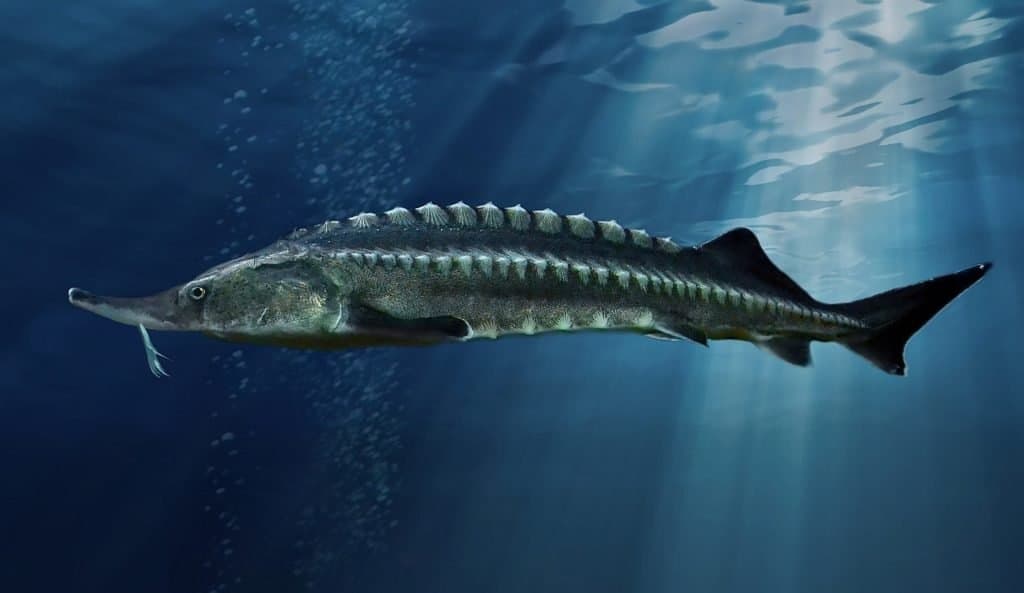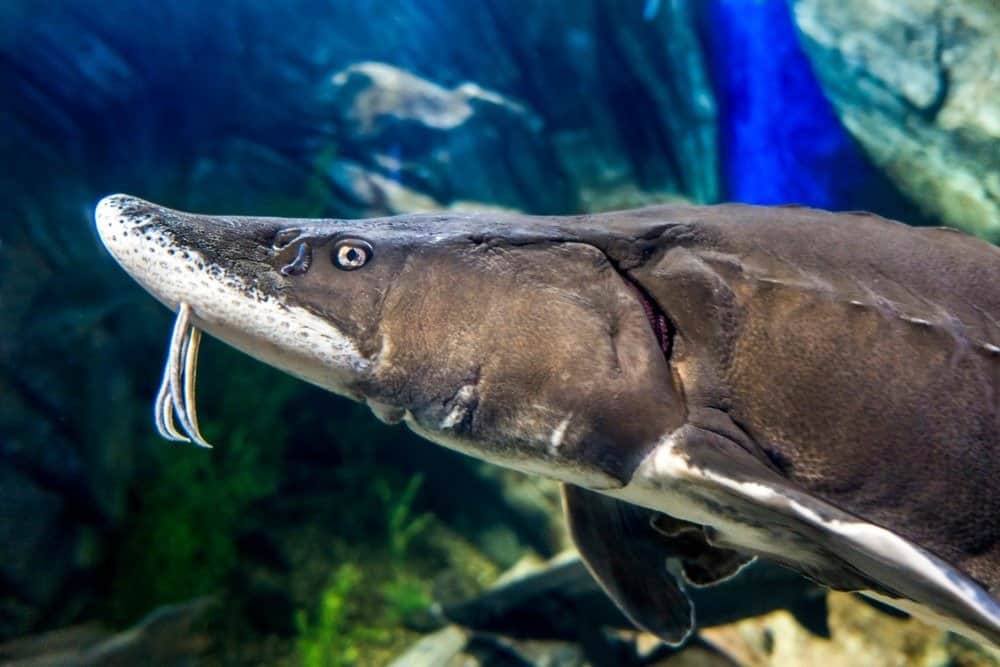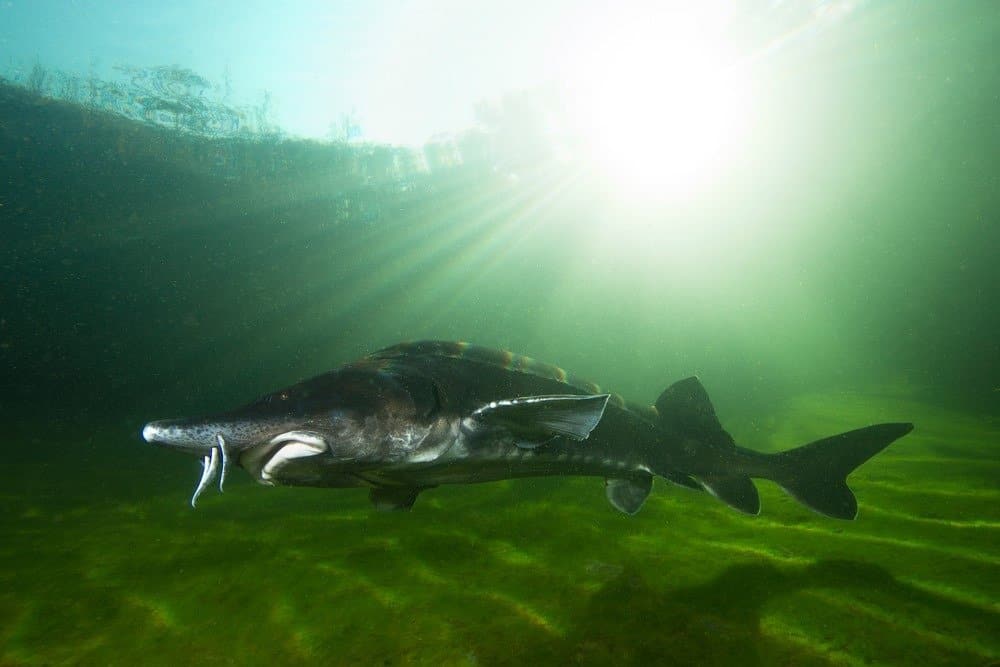Beluga Sturgeon
Huso huso
The beluga sturgeon is one of the largest bony fish in the world!
Advertisement
Beluga Sturgeon Scientific Classification
- Kingdom
- Animalia
- Phylum
- Chordata
- Class
- Actinopterygii
- Order
- Acipenseriformes
- Family
- Acipenseridae
- Genus
- Huso
- Scientific Name
- Huso huso
Read our Complete Guide to Classification of Animals.
Beluga Sturgeon Conservation Status
Beluga Sturgeon Facts
- Prey
- Fish
- Group Behavior
- Solitary/Group
- Fun Fact
- The beluga sturgeon is one of the largest bony fish in the world!
- Estimated Population Size
- Unknown
- Biggest Threat
- Overfishing
- Most Distinctive Feature
- The bony armor
- Other Name(s)
- Great sturgeon
- Gestation Period
- A few days
- Habitat
- Rivers, estuaries, and seas
- Diet
- Carnivore
- Type
- Fish
- Common Name
- Beluga
View all of the Beluga Sturgeon images!
Endemic to the Caspian and Black Seas, the beluga sturgeon is impressive in its size.

As one of the largest bony fish in the world, this species has no known natural predators anywhere in its native habitat. However, the degradation of the Caspian Sea from unregulated fishing and industry has led to its inevitable decline. The beluga sturgeon, also called the great sturgeon, is now at risk of complete extinction.
3 Incredible Facts!
- The name beluga, used for both the beluga sturgeon and the Arctic beluga whale, comes from the Russian word belaya, meaning white. Interestingly, this is also the origin of the name for the country of Belarus, meaning literally Whit Rus (Rus for Russia).
- Despites its size, the beluga fish is actually a rather shy creature that always seems to avoid contact with people.
- One of the more interesting facts is that the beluga sturgeon is a fish that has been hunted as a food for the quality of its eggs since at least 1,100 BC. Roe is a term that refers to any fish eggs in general. Caviar, by contrast, refers specifically to the internal eggs of any sturgeon species that lives in the Caspian and Black Seas.
Scientific Name and Evolution

The bony armor of the Beluga Sturgeon is the reason for its scientific name.
The scientific name of the beluga is Huso huso. This appears to derive from an Old German word meaning skull, possibly in reference to the large armored head. The only other member of the genus is the kaluga or the river beluga (Huso dauricus). Both species belong to the family of sturgeons known as Acipenseridae. Other species in the family include the white sturgeon, the short-nose sturgeon, and the green sturgeon.
Evolving more than 200 million years ago, the sturgeon is one of the most “primitive” types of bony fish still living. In this case, primitive doesn’t mean a lack of sophistication or development, but refers to a trait that appeared first in a common ancestor on its family tree and has been passed on largely intact to more recent beluga sturgeons. Both their body structure and the presence of armored plates are testament to their ancient lineage.
Appearance
Like many other species of sturgeons, the beluga is a fish with a long and big body with a rounded “hump,” a series of bony external plates along the side and top, and a big asymmetric tail that’s almost shark-like in appearance. The long “snout” sticking out from the face contains a pair of whisker-like barbels (similar to the ones found in catfish) that serve the purpose of providing information about the surrounding environment. This helps it find prey in the water.

A beluga sturgeon, if allowed to grow to full maturity, can weigh well over 4,000 pounds.
©Mick Rush/Shutterstock.com
The adult sturgeon is white, blue, and gray in color. Weighing, on average, 500-2000 lbs., there have been some that weighed up to 4000 pounds or more (and stretching almost 20 feet). Females are about 20% bigger than males. Few other species can compare to its formidable size; It’s almost as big as a modern pickup truck.
Distribution, Population, and Habitat
The beluga sturgeon is mostly at home in the Caspian Sea. Split between the countries of Russia, Kazakhstan, Azerbaijan, Turkmenistan, and Iran in Central Asia, this gigantic body of water is the largest inland sea in the world. It is fed by more than 100 rivers, including the mighty Volga, which runs all the way to the north of Moscow. The beluga is also endemic to the Black Sea and the Sea of Azov between Turkey and Russia, and some can be found in the Mediterranean Sea.
This species has adapted to routine life in both freshwater rivers and saltwater areas. It spends the majority of its life near the sea coast and then moves upriver in the spawning season to produce offspring. The technical term for this type of lifestyle is euryhaline, meaning it can tolerate a range of different salinities.
Predators and Prey

Beluga sturgeons has no natural predators. Its prey are other types of fish.
©Miroslav Halama/Shutterstock.com
The beluga sturgeon is one of the few sturgeon species that consumes other types of fish. It patrols the middle depths of the water, preying on the flounder, gobies, anchovies, herring, and whatever other species of fish happen to be available at the time.
Because of its size and strong armor, the adult beluga sturgeon has no natural predators except, of course, for humans (though larvae may be picked off by other fish). Because of the premium placed on the eggs of the beluga, it is hunted relentlessly throughout the region.
Overfishing, combined with pollution and habitat loss from industry and dams, has nearly driven this species to extinction. Despite receiving some limited protection by local governments, the beluga’s decline continues almost unabated. This critically endangered species is now completely gone from many parts of its former range.
Reproduction and Lifespan
Beluga sturgeon spawn in two stages. First, they migrate into a river in the autumn and overwinter there. When it is ready to spawn in the spring, the beluga begins to move inland through the estuaries and rivers. Some individuals will travel more than a thousand miles up the Danube, Volga, or other nearby rivers to spawn.
Like many species of fish, the beluga reproduces externally. This is accomplished when the male and female release their eggs and sperm (usually more than a million of them) separately into the water. If the conditions aren’t suitable for spawning, then the female can choose to reabsorb the eggs and try again later. Females reproduce only every four to eight years, on average.

This Beluga Sturgeon is swimming in a river where it spawns. Its progeny will be only a few inches in size when they leave the river for the sea.
©Rostislav Stefanek/Shutterstock.com
The juveniles emerge from the eggs after a short time with a rather thin and small body. By the time they reach the sea (usually around May or June), they are still only a few inches in size. In order to grow, the sturgeon has a very long development time and lifespan, most of which is spent alone. It will only achieve full sexual maturity at between six and 25 years of age.
The life expectancy of a beluga is usually at least 50 years in the wild, but it is almost always caught and killed by fishers before it can die of natural causes. If it does somehow manage to evade human capture, the sturgeon lifespan is truly prolific. One specimen was once observed to live for more than a century.
Fishing and Cooking
To the detriment of this species, the beluga sturgeon is one of the most highly desired catches in the entire world. They are usually quite easy to catch upriver by net or harpoon because of the predictable nature of their spawning.
The beluga does have edible meat that tastes similar to the swordfish, but that isn’t the main reason why it’s caught. Instead, the beluga’s caviar is considered to be a food delicacy around the world. It is sometimes worth as much as $3,500 per pound. Because of the amount of eggs produce by a single female, the beluga sturgeon is a very valuable species.
It is not entirely known how many are caught each year, but it is more than enough to reduce population numbers. Because fishers sometimes can’t distinguish between males and females, both sexes are caught up in the catch. In order to have any hopes of rehabilitating this species, something would need to be done about the international caviar trade.
View all 284 animals that start with BBeluga Sturgeon FAQs (Frequently Asked Questions)
Is beluga a whale?
The beluga is actually a species of fish. The confusion may arise from the fact that both the beluga sturgeon and the beluga whale share a similar name. The facts remain, however, that apart from their swimming ability, they are actually nothing alike. The beluga sturgeon is a type of ray-finned fish that belongs to the class of Actinopterygii. The beluga whale, as the name suggests, is a type of whale that lives around the Arctic. With the ability to produce milk, the Arctic beluga whale is just as much of a mammal as any primate or rodent.
What do belugas eat?
Beluga sturgeons consume flounder, gobies, anchovies, roach, herring, and other fish for food.
Where do belugas live?
The beluga sturgeon spends most of its time in saltwater seas. When spawning season approaches, it travels more than a thousand miles on average upstream along the Volga, Danube, and other rivers around the Caspian and Black Seas.
Do belugas attack humans?
Beluga sturgeons pose no known threat to humans. They will actively try to avoid human contact.
Are belugas dangerous?
Despite their size, beluga sturgeons are not particularly aggressive or dangerous. They are adapted for the consumption of small- to medium-sized fish and not larger animals like humans. If they are attacked, then belugas may try to fight back, but otherwise, they will mind their own business.
What Kingdom do Beluga Sturgeons belong to?
Beluga Sturgeons belong to the Kingdom Animalia.
How do Beluga Sturgeons have babies?
Beluga Sturgeons lay eggs.
Thank you for reading! Have some feedback for us? Contact the AZ Animals editorial team.
Sources
- Animal Diversity Web / Accessed November 26, 2020
- Oceana / Accessed November 26, 2020


















